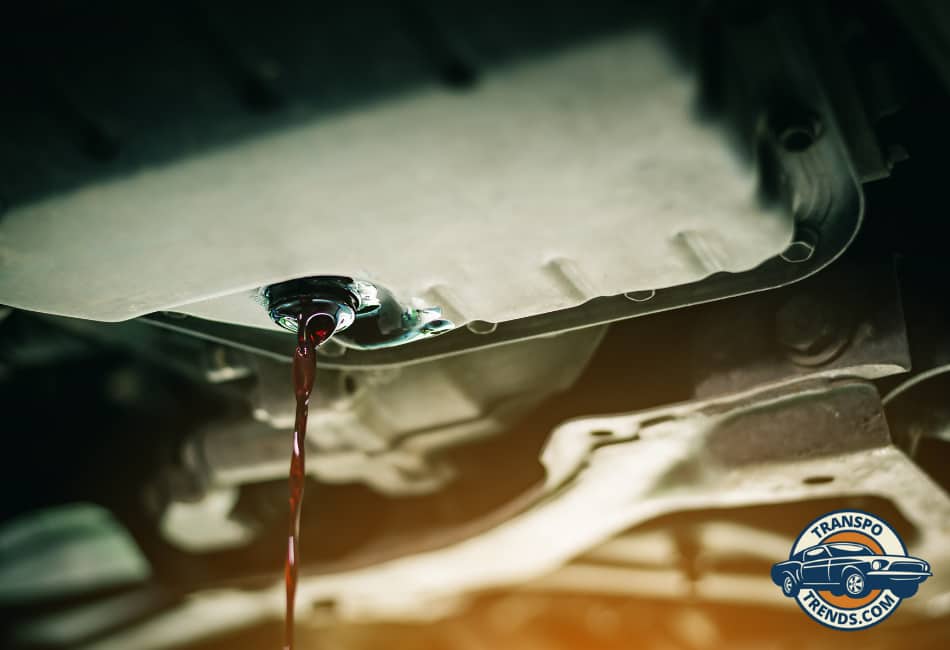Cars are complex machines, a symphony of intricate parts working harmoniously to ensure smooth and efficient performance.
Among these components, various essential fluids operate as the vehicle’s lifeblood, lubricating, cooling, and cleaning to keep everything running optimally. One such vital fluid is the transmission fluid.
It plays a crucial role in maintaining your car’s functionality and performance, ensuring smooth gear shifts, and prolonging the lifespan of your transmission. But how long can a car run without transmission fluid?
Understanding Transmission Fluid
Transmission fluid plays a pivotal role in ensuring the smooth operation of a vehicle’s transmission system.
It is specifically designed to meet the unique requirements of transmission components by facilitating smooth gear shifts and minimizing friction between moving parts.
The transmission fluid acts as a lubricant for the gears and components within the transmission system, ensuring they don’t grind against each other and cause wear or damage.
This protective role prevents premature wear and tear, thereby extending the lifespan of the transmission system as a whole.
However, it’s essential to note that the type and specifications of transmission fluid vary between manual and automatic vehicles.
Manual transmission fluid, typically thicker, is primarily used to lubricate gears to ensure seamless shifting. On the other hand, automatic transmission fluid has a dual role.
It acts as a lubricant, similar to its counterpart in manual transmissions, but also serves as the hydraulic fluid that aids in the operation of the automatic transmission system.
Understanding these differences and using the appropriate fluid recommended by your vehicle’s manufacturer is crucial in maintaining optimal transmission performance.
Signs of Low Transmission Fluid
Recognizing the signs of low transmission fluid before it escalates into severe issues is essential. Here are some common indicators that your car may be running low on transmission fluid:
1. Difficulty in Changing Gears
When there’s not enough transmission fluid, shifting gears can become challenging. You may notice that your car hesitates or refuses to go into gear.
2. Leakage Underneath the Car
If you notice a reddish liquid under your car, it could be a sign of a transmission fluid leak. It’s crucial to address this immediately to prevent further damage.
3. Burning Smell or Smoke from the Engine
A burning smell or smoke emanating from under the hood is a serious indicator of low transmission fluid.
The friction caused by insufficient lubrication can lead to overheating, producing a noticeable smell or smoke.
4. Increased Engine Temperature
Transmission fluid cools the transmission. If the fluid level is low, your transmission may overheat, resulting in an increase in engine temperature.
5. Delayed Gear Engagement
A noticeable delay before the car engages into drive or reverse is a clear sign of low transmission fluid.
6. Grinding Noises and Engine Light Warnings
Unusual grinding noises or lit-up warning lights on your dashboard could indicate low transmission fluid.
If you encounter any warning signs, it’s important to check your transmission fluid level and consult a professional mechanic immediately.
Regular checks and maintenance can prevent these signs from appearing and save you from potentially hefty repair bills.
What Happens if You Drive Without Transmission Fluid
Driving with inadequate transmission fluid is a precarious venture that can have extensive ramifications on your vehicle’s performance and lifespan. Let’s delve into the specific effects of low fluid levels:
- Increased Friction and Wear on Transmission Components
An insufficient supply of transmission fluid will lead to increased friction between your car’s components.
This results in excessive wear and tear, potentially shortening the lifespan of your transmission system.
- Overheating and Potential Engine Damage
Transmission fluid plays a vital role in regulating the temperature of your car’s transmission system.
A low fluid level can cause your vehicle to overheat, posing a significant risk of engine damage.
- Loss of Hydraulic Pressure and Gear Slippage
Transmission fluid is essential for maintaining hydraulic pressure for seamless gear shifts. Without enough fluid, your car may experience gear slippage, impacting its performance and safety.
- Seals and Gaskets Drying Out, Leading to Leaks
Transmission fluid keeps the seals and gaskets in your car lubricated and pliable. Low fluid levels can lead to these components drying out and cracking, causing leaks.
- Transmission and Engine Malfunction
In the worst-case scenario, driving with inadequate transmission fluid can lead to complete transmission failure and engine malfunction. This can be an expensive issue to fix and drastically reduce your vehicle’s lifespan.
How Long Can You Realistically Drive Without Transmission Fluid?
It’s crucial to understand that driving without adequate transmission fluid is neither recommended nor safe, but sometimes circumstances might compel you to wonder: how far can you really go?
Garage experts suggest that in a dire situation, a vehicle can cover a distance of up to 10 miles without transmission fluid.
However, this is a rough estimate and varies greatly depending on the car’s make, model, and condition.
While this figure might offer a glimmer of hope in an emergency, the potential damage that could occur within this short distance cannot be overstated.
Remember, transmission fluid isn’t just for lubrication; it cools, cleans, and protects the transmission.
Driving without it, even for a short distance, can cause severe damage to your transmission system.
The risks include overheating, increased friction and wear on transmission components, loss of hydraulic pressure, and transmission and engine failure.
Therefore, the consensus among automobile experts is clear: avoid driving without transmission fluid at all costs.
Even if you manage to reach your destination, the potential harm to your vehicle may result in costly repairs or replacements, far outweighing any immediate convenience gained.
The Importance of Regular Maintenance
Regular maintenance of your vehicle plays a crucial role in preventing low transmission fluid. Frequent fluid checks and inspections are recommended to keep your vehicle in optimal condition.
These inspections can identify potential issues before they escalate into serious problems. Regular servicing can also ensure your transmission fluid is at the appropriate level, maintaining the health and function of your transmission system.
Steps to Maintain Transmission Fluid Levels
Maintaining adequate transmission fluid levels is simpler than you may think. Here’s how to check your transmission fluid using the dipstick:
- Park your car on a level surface and apply the parking brake.
- Start the engine and let it run for a few minutes to warm the fluid.
- Locate the transmission fluid dipstick (refer to your vehicle’s manual if needed).
- Pull out the dipstick, wipe it clean, then reinsert it fully.
- Pull it out again and check the level of the fluid on the dipstick.
If necessary, you can top up the transmission fluid. Always follow the manufacturer’s recommendations for fluid type and change intervals to ensure your vehicle runs smoothly.
Preventive Measures for Transmission Health
To maintain a healthy transmission, practice smooth driving habits to reduce stress on the transmission.
Ensure your cooling system works properly to prevent overheating, a common cause of transmission problems.
If you notice any signs of transmission issues—such as jerky shifts, leaking fluid, or unusual noises—have your vehicle inspected immediately to prevent further damage.
The Bottom Line: Avoiding Catastrophic Damage
Driving without transmission fluid poses immediate risks to your vehicle, including severe transmission and engine damage.
It’s essential to prioritize regular maintenance and address any issues promptly to prevent these serious consequences.
Conclusion
In conclusion, transmission fluid is vital for your car’s proper functioning. Neglecting it can result in catastrophic damage and costly repairs.
Make responsible driving and regular maintenance a priority to ensure your vehicle remains reliable and safe.
By taking these steps, you can extend the lifespan of your vehicle and enjoy smoother, worry-free driving.
FAQs
Q: How often should I change my transmission fluid?
A: It depends on the make and model of your vehicle. Refer to your manual for specific instructions, or contact a qualified mechanic for advice.
Q: Can I add transmission fluid myself?
A: You can purchase transmission fluid from automotive stores and add it yourself, following the instructions in your car manual. However, if your vehicle shows signs of transmission issues, inspect it by a qualified mechanic before adding new fluid.
Q: Can I use any transmission fluid?
A: Not all fluids are compatible with different transmissions, so selecting the correct one for your vehicle is important. Refer to your manual or contact a qualified mechanic to advise which fluid is best for you.
Q: What happens if I overwarm my transmission?
A: Overheating can cause the seals in your transmission to fail, leading to fluid leakage and more serious damage. Avoid driving in extreme temperatures, and make regular stops to keep your vehicle cool. Monitor temperature levels and use a cooling system if necessary.
Q: Can I mix different types of transmission fluids?
A: No, you should not mix different types of transmission fluid as it can cause damage to your car. You should always use the type specified in your manual and avoid mixing with other fluids.

